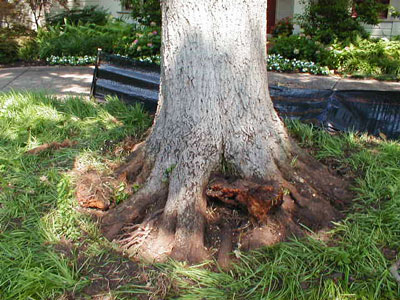Base Investigation and Clearing Root Flares Using the Air-Spade

Published January 2, 2018, By ARBORILOGICAL SERVICES

The Air-Spade is a hand-held soil excavation tool connected to a large air compressor. The high pressure stream of air is funneled through a small nozzle breaking dense soils apart into small particles. By using air to excavate soil, delicate roots, underground pipes, and hard surfaces are not damaged. Arborists can recommend using the Air-Spade for many reasons.
AIR-SPADE USES
- Expose root flares of trees planted too deep.
- Expose root flares of trees covered with fill dirt.
- Expose root flares and root structure 6” to 18” below grade for base investigation.
- Expose root flares for Macro-Injections.
- Dig trenches without cutting roots or concrete.
The root flare or root collar is the area where a tree begins to taper outward at ground level. This is a critical part of the tree where trunk tissue changes into root tissue. If this area is covered with soil and kept moist for extended periods of time, the tissue begins to breakdown. This leaves the tree vulnerable to root decay and ultimately poor health and vigor.
Base investigation is needed when an arborist suspects deterioration of root tissue. Since roots can not be seen above the surface, the only way to confirm this suspicion is to excavate the soil and inspect the root structure.
Clearing root flares for Macro-Injections is another common use for the Air-Spade. Macro-Injection is an application method used to apply chemicals such as Alamo for Oak Wilt management. Soil and debris are removed quickly and easily without damage.
EXPECTATIONS OF AIR-SPADE WORK
- Preparing the Soil — Water the soil area around the tree one or two days prior to the Air-Spade work being done. This will soften the soil and expedite the process.
- Clearing the Work Area — The work area around the tree will need to be prepared. Prior to the movement of soil, we will remove any grass, ivy, shrubs, or flowers from around the base of the tree. This work area is typically one to two feet from the base of the tree. We do not preserve the vegetation in most cases and request you salvage any plant material you want to keep. We do not replace the vegetation removed.
- Noisy Process — Due to the high pressure air being used and the compressor needed, the process can be quite noisy.
- Backfilling the Excavated Area — When excavating a root flare, the void created can sometimes be quite deep. If the area cannot be left open, it can be filled with coarse mulch. When the area exposed is greater than eight inches deep, medium to large stone can be used to backfill the area insuring greater air circulation around the base.

